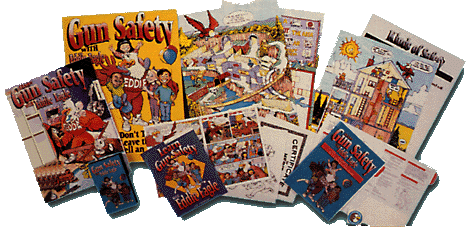 Program Mission Statement
Program Mission Statement Program Mission Statement
Program Mission StatementTo serve as the national leader in providing gun safety information to elementary school children, pre-k through sixth grade.
 Program Features
Program Features Program Materials
Program MaterialsThe gun safety concepts and materials were developed from study results and resource materials of a safety task force composed of specialists in the field of education and child development. The task force was formed for the specific purpose of developing a gun safety program for elementary school students that would accommodate the needs of both the teacher and the student. Courses are available for three levels: grades Preschool - Grade 1, Grades 2-3 and Grades 4-6.
Parents should play an important role in developing safe practices. They are ultimately responsible for the behavior and safety of their children. Because isolated facts and concepts can be quickly forgotten, repetition of concepts will help students remember the safety procedures. A message to parents is incorporated in the take-home materials to encourage parents to reinforce the safety rules and give proper guidance to their children.

 Program Theme
Program ThemeThere are two safety practices that young children need to know to be safe around guns.
Parents are ultimately responsible for the care, safety, and development of their children. It is important for the instructor to reinforce the necessity of parental approval. It is the parents' decision whether or not to further his child's gun safety education.
Regardless of whether guns are in the home, most children are curious about guns. That curiosity is equally strong among children who grow up in homes without guns as it is in those who grow up in gun-owning households. All children need to be taught basic gun safety in order to be prepared in case they come in contact with a gun. Where there is no parental permission or adult supervision, children must know what to do.
This practice applies to any situation where a gun is accessible to a youngster and there is no parental or adult supervision. It is important that a curious child resist the temptation to pick up the gun. In all cases, children should know to leave the area, and tell their parents or another responsible adult who can secure the gun. The adult can then eliminate a potentially dangerous situation.
 Program Levels
Program LevelsDepending on the comprehension level of the children, some terms may need to be explained. For example, children may not understand what is meant by the phrase, "leave the area." The teacher is asked to discuss the concept of "area." Is it the room, the house, the playground, the street corner?
If the children are not familiar with guns, it may be necessary to explain or show graphically what a gun is. Children may have seen people using guns on television. The teacher is asked to explain that guns on television are toys. People on television shows pretend to be shot and die. It's not real. In real life, in all cases, children must follow the safety practices when they come across a gun. They must understand the potential harm that can occur if these safety practices are not followed. Guns are not toys.
Safety education materials designed especially for the ages and development levels of your students are available. Coloring books, for distribution on the same day as the presentation, are provided, and the students should be asked to show them to their parents. The coloring sheets are provided for follow-up reinforcement. The gun safety poster should be put up in the classroom for permanent display.
Young people in grades 2-6 are more prone to be curious about guns. They may have developed varying perceptions of fantasy and reality. Television and movies can distort their perceptions. Students at these grade levels need to understand that gun use on television is fantasy. People on television pretend to be shot and die. This age group needs to know that guns are not toys and that showing off with guns is not "cool."
Some children at this age may own BB and pellet guns. These guns are not toys and when handling them, children should treat them accordingly. If BB and pellet guns are not handled properly and with adult supervision, they can cause serious injury.
Activity sheets in the form of word finds, a word game and a cryptoword are also available. These activity sheets should be used by the classroom teacher for follow-up reinforcement. The gun safety poster should be put up in the classroom for permanent display.
 Program
Credits
Program
CreditsThe Eddie Eagle Program task force included:
Copyright ©1996 National Rifle Association, 11250 Waples Mill Road, Fairfax, VA 22030